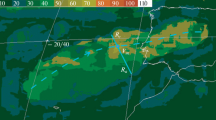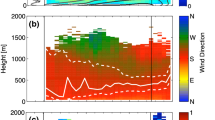Abstract
A new jet stream description, defined as the geostrophic streamline of maximum average velocity is proposed. An objective algorithm for detecting and tracking the jet has been developed, tested and applied to the NCEP/NCAR 200-hPa geopotential height in the Southern Hemisphere for the period 1958–2002. The results show the variability of the double character of the Southern Hemisphere jet, with a marked seasonality. During the warm season, a single jet can be found around 40°S, while autumn and winter are characterized by a clear double jet structure, with a strong and dominant subtropical jet located around 30°S and a polar front jet, progressively displaced toward southern latitudes and reaching 60°S by the end of the cold season. In general, a trend toward slower subtropical jets and stronger polar front jets has been detected during the study period. The Southern Annular Mode appears as a main modulator of the latitude and strength of the polar front jet, influencing to a minor extent its subtropical counterpart. The ENSO cycle strongly modifies the latitude and specially the strength of the subtropical jet, affecting its preferred wavenumber as well. Nevertheless, the effect of this oscillation seems fairly restricted in the Pacific, thus limiting the ability of this jet to drive the El Niño teleconnections along the Southern Hemisphere. The consistency of the results, when compared with previous jet climatologies, suggests that the new approach is a reliable jet-tracking method, thus providing a new tool to analyze climatic variability at hemispheric scales.











Similar content being viewed by others
References
Bals-Elsholz TM, EH Atallah, LF Bosart, TA Wasula, Cempa MJ, Lupo AR (2001) The wintertime Southern Hemisphere split jet: structure, variability, and evolution. J Climate 14:4191–4215
Burnett AW, McNicoll AR (2000) Interannual variations in the Southern Hemisphere winter circumpolar vortex: relationships with the semiannual oscillation. J Climate 13:991–999
Carleton A (2003) Atmospheric teleconnections involving the Southern Ocean. J Geophys Res 108(C4):8080. DOI 10.1029/2000JC000379
Davis RE, Benkovic SR (1994) Spatial and temporal variations of the January circumpolar vortex over the Northern Hemisphere. Int J Climatol 14:415–428
Gong D, Wang S (1999) Definition of Antarctic Oscillation index. Geopys Res Lett 26:459–462
Hall A, Visbeck M (2002) Synchronous variability in the Southern Hemisphere atmosphere, sea ice, and ocean resulting from the annular mode. J Climate 15:3043–3057
van Heerden J, Taljaard JJ (1998) Africa and surrounding waters. In: Karoly DJ, Vincent DG (eds) Meteorology of the Southern Hemisphere (Meteorological monographs, vol. 27, No 49). American Meteorological Society, Boston, pp 141–174
Hurrell JW (1995) Decadal trends in the North Atlantic Oscillation regional temperatures and precipitation. Science 269:676–679
Hurrell JW, Kushnir Y, Ottersen G, Visbeck M (eds) (2003) The North Atlantic Oscillation: climate significance and environmental impact. Geophys Monogr Ser 134:279
Kalnay E et al (1996) The NCEP/NCAR 40-year reanalysis project. Bull Am Meteor Soc 77:437–471
Karoly DJ, Vincent DG (eds) (1998) Meteorology of the Southern Hemisphere (Meteorological monographs, vol. 27, no 49). American Meteorological Society, Boston, pp 410
Kidson JW (1975) Eigenvector analysis of monthly mean surface data. Mon Wea Rev 103:177–186
Kidson JW (1999) Principal modes of Southern Hemisphere low-frequency variability obtained from NCEP/NCAR reanalyses. J Climate 12:2808–2830
Kidson JW, MR Sinclair (1995) The influence of persistent anomalies on Southern Hemisphere strom tracks. J Climate 8:1938–1950
Kistler R et al (2001) The NCEP/NCAR 50-year reanalysis: monthly means CD-ROM and documentation. Bull Am Meteor Soc 82:247–268
van Loon H, Rogers JC (1978) The seesaw in winter temperatures between Greenland and northern Europe. Part I: General description. Mon Wea Rev 106:296–310
van Loon H, Kidson JW, Mullan AN (1993) Decadal variation of the annual cycle in the Australian dataset. J Climate 6:1227–1231
Marshall GJ (2002) Trends in Antarctic geopotential height and temperature: a comparison between radiosonde and NCEP/NCAR reanalysis data. J Climate 15:659–674
Mechoso CR, Farrara JD, Ghil M (1991) Intraseasonal variability of the winter circulation in the Southern Hemisphere atmosphere. J Atmos Sci 48:1387–1404
Menendez CG, Serafin V, Le Treut H (1999) The storm tracks and the energy cycle of the Southern Hemisphere: sensitivity to sea-ice boundary conditions. Ann Geophys 17:1478–1492
Mo KC (2000) Relationships between low-frequency variability in the Southern Hemisphere and sea surface temperature anomalies. J Climate 13:3599–3610
Nascimiento E, Ambrizzi T (2002) The influence of atmospheric blocking on the Rossby wave propagation in Southern Hemisphere winter flows. J Meteor Soc Japan 80(2):139–159
Orlanski I, Katzfey J, Menendez C, Marino M (1991) Simulation of an extratropical cyclone in the Southern Hemisphere: model sensitivity. J Atmos Sci 48:2293–2311
Press WH, Flannery BP, Teukolsky SA, Vetterling WT (1992) Numerical recipes in FORTRAN: the art of scientific computing, 2nd edn. Cambridge University Press, Cambridge, pp 992
Renwick JA (2004) Trends in the Southern Hemisphere polar vortex in NCEP and ECMWF reanalyses. Geophys Res Lett 31:L07209. DOI 10.1029/2003GL019302
Rind D, Chandler M, Lerner J, Martinson DG, Yuan X (2001) The climate response to basin-specific changes in latitudinal temperature gradients and the implications for sea ice variability. J Geophys Res 106(D17):20161–20173
Simmonds I (2003) Modes of atmospheric variability over the Southern Ocean. J Geophys Res 108(C4):8078. DOI 10.1029/2000JC000542
Simmonds I, Keay K (2000a) Variability of Southern Hemisphere extratropical cyclone behaviour, 1958–1997. J Climate 13:550–560
Simmonds I, Keay K (2000b) Mean Southern Hemisphere extratropical cyclone behavior in the 40-year NCEP-NCAR reanalysis. J Climate 13:873–885
Thompson DWJ, Solomon S (2002) Interpretation of recent Southern Hemisphere climate change. Science 296:895–899
Thompson DWJ, Wallace JM (1998) The Arctic oscillation signature in the wintertime geopotential height and temperature fields. Geophys Res Lett 25:1297–1300
Thompson DWJ, Wallace JM (2000) Annular modes in the extratropical circulation, part I: month-to-month variability. J Climate 13:1000–1016
Trenberth KE (1981) Observed Southern Hemisphere eddy statistics at 500 mb: frequency and spatial dependence. J Atmos Sci 38:2585–2605
Trenberth KE (1991) Strom tracks in the Southern Hemisphere. J Atmos Sci 48:2159–2178
Vera C (2003) Interannual and interdecadal variability of atmospheric synoptic-scale activity in the Southern Hemisphere. J Geophys Res 108(C4):8077. DOI 10.1029/2000JC000406
Vincent DG, Silva-Dias PL (1998) Pacific Ocean. In: Karoly DJ, Vincent DG (eds) Meteorology of the Southern Hemisphere (Meteorological monographs, vol. 27, no 49). American Meteorological Society, Boston, pp 101–117
Wallace JM (2000) North Atlantic Oscillation/Northern Hemisphere annular mode: two paradigms one phenomenon. Quart J Roy Meteor Soc 126:791–805
Wiedenmann J, Lupo AR, Mokhov II, Tikhonova EA (2002) The climatology of blocking anticyclones for the Northern and Southern Hemispheres: block intensity as a diagnostic. J Climate 15:3459–3473
Yuan X, Martinson DG (2001) The Antarctic dipole and its predictability. Geophys Res Lett 28(18):3609–3612
Acknowledgments
The authors wish to thank the two anonymous referees for their useful comments, which have contributed to the improvement of this work.
Author information
Authors and Affiliations
Corresponding author
Rights and permissions
About this article
Cite this article
Gallego, D., Ribera, P., Garcia-Herrera, R. et al. A new look for the Southern Hemisphere jet stream. Climate Dynamics 24, 607–621 (2005). https://doi.org/10.1007/s00382-005-0006-7
Received:
Accepted:
Published:
Issue Date:
DOI: https://doi.org/10.1007/s00382-005-0006-7




